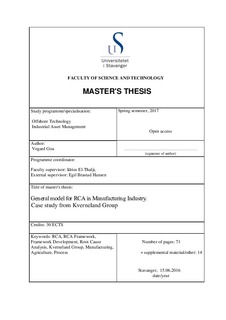| dc.contributor.advisor | El-Thalji, Idriss | |
| dc.contributor.author | Goa, Vegard | |
| dc.coverage.spatial | Norway | nb_NO |
| dc.date.accessioned | 2017-10-13T12:50:58Z | |
| dc.date.available | 2017-10-13T12:50:58Z | |
| dc.date.issued | 2017-06 | |
| dc.identifier.uri | http://hdl.handle.net/11250/2460093 | |
| dc.description | Master's thesis in Offshore technology: Industrial asset management | nb_NO |
| dc.description.abstract | There were two main goals of this thesis. The first was to conduct a Root Cause Analysis of a unit called A275 in the facilities of Kverneland Group Klepp. This unit had problems with excessive downtime. Based on that analysis, the second goal was to use the insights gained by in the process of analyzing A275 to develop a new, modified Root Cause Analysis framework that was specifically suited to be used by the Kverneland Group at their facilities. This was important for Kverneland Group as the framework they used previously was too time consuming to be properly used.
The approach was to first conduct a Root Cause Analysis of A275. This process was completed with a combination of conversation with key-personnel at Kverneland Group and examination and analysis of their maintenance database. By applying Root Cause Analysis methods, the root causes were discovered to be the absence of a feedback system between two systems inside one of a sub-unit of A275. A theoretical solution was presented at the end of the analysis.
Based on the information and methods applied to analyze unit A275, as well as the general structure and processes of the units at Kverneland Group Klepp a new Root Cause Analysis framework was developed.
The Root Cause Analysis framework was developed based on requirements from Kverneland Group, background theory and modifications which made the framework more suited to be used at their facilities. Based on an example Root Cause Analysis conducted over A275 using the developed framework, it was found that the process was quicker and more intuitive to use even for people with limited experience with Root Cause Analysis. | nb_NO |
| dc.language.iso | eng | nb_NO |
| dc.publisher | University of Stavanger, Norway | nb_NO |
| dc.relation.ispartofseries | Masteroppgave/UIS-TN-IKM/2017; | |
| dc.rights | Attribution-NonCommercial-NoDerivatives 4.0 Internasjonal | * |
| dc.rights | Navngivelse-Ikkekommersiell-DelPåSammeVilkår 4.0 Internasjonal | * |
| dc.rights.uri | http://creativecommons.org/licenses/by-nc-sa/4.0/deed.no | * |
| dc.subject | offshore teknologi | nb_NO |
| dc.subject | driftledelse | nb_NO |
| dc.subject | rca | nb_NO |
| dc.subject | rca framework | nb_NO |
| dc.subject | root cause analysis | nb_NO |
| dc.subject | kverneland group | nb_NO |
| dc.subject | manufacturing | nb_NO |
| dc.subject | agriculture | nb_NO |
| dc.subject | process | nb_NO |
| dc.subject | industrial asset management | nb_NO |
| dc.title | General model for RCA in Manufacturing Industry. Case study from Kverneland Group | nb_NO |
| dc.type | Master thesis | nb_NO |
| dc.subject.nsi | VDP::Teknologi: 500::Marin teknologi: 580::Offshoreteknologi: 581 | nb_NO |

